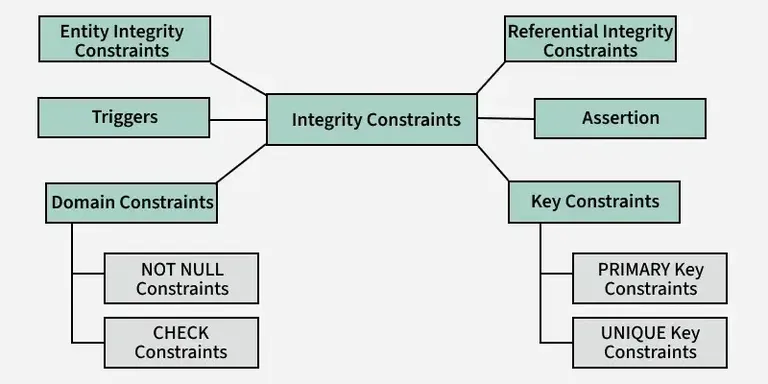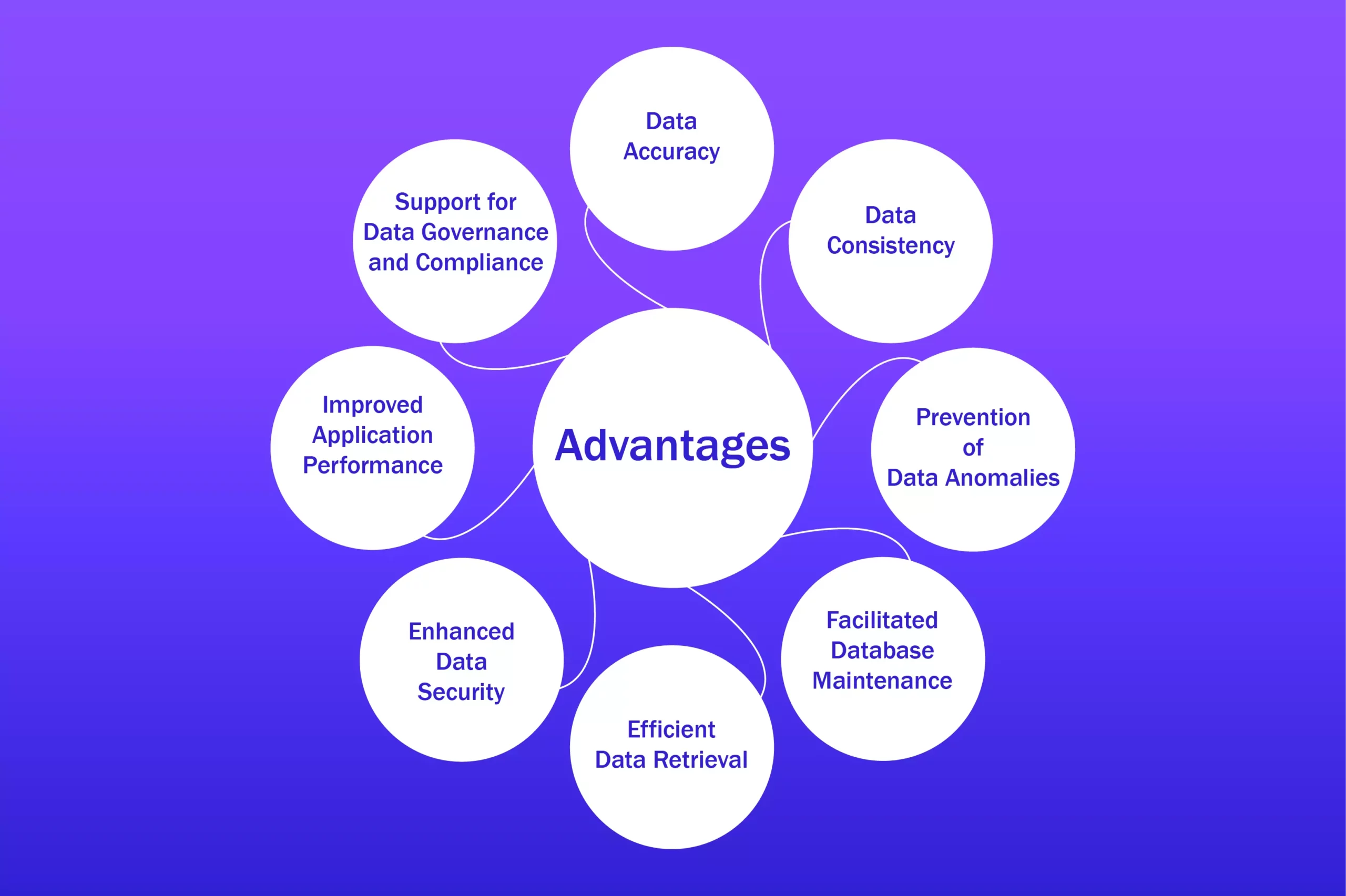Integrity Constraints in DBMS: What They Are and Why They Matter
Table of Contents

In the vast and ever-evolving world of data management, ensuring that data remains accurate, consistent, and reliable is a top priority. One of the most crucial components of a reliable database system is the implementation of integrity constraints in DBMS. These constraints act as a set of rules that the database follows to preserve data validity and eliminate errors, anomalies, or inconsistencies.
When large volumes of data are being stored, modified, or retrieved from databases across different sectors — finance, healthcare, education, e-commerce, and logistics — it becomes essential to maintain structure and discipline within the data architecture. This is where integrity constraints in DBMS play a vital role. They ensure that no matter how complex or large the system becomes, it maintains internal logic and stability.

*media.geeksforgeeks.org
Understanding the Concept of Integrity Constraints in DBMS
At its core, integrity constraints in DBMS are a collection of logical rules applied to the contents of a database to ensure data correctness and consistency. These rules are defined at the schema level and automatically enforced by the database system itself. They are designed to restrict the kind of data that can be inserted, updated, or deleted in the database.
Without integrity constraints in DBMS, a database would become an unregulated space where contradictory, duplicate, or logically invalid data could accumulate. This would lead to severe problems such as financial misreporting, medical misdiagnosis, and failed business operations, especially in systems where the slightest error can have significant consequences.

*cdn.prod.website-files.com
Why Are Integrity Constraints in DBMS Important?
The importance of integrity constraints in DBMS lies in their ability to act as safeguards for your data. They help define what is acceptable and what is not within your data model. These constraints prevent situations where a user might accidentally input incorrect data, remove critical information, or violate business rules.
For example, in a database managing employee information, it would be unacceptable to allow duplicate employee IDs or to leave important fields like date of joining or salary blank. These are fundamental business rules that must be upheld in all circumstances. Enforcing integrity constraints in a DBMS ensures that such rules are respected by all users and applications interacting with the system.
Moreover, in environments where multiple users are accessing and modifying data simultaneously, such as in a cloud-based enterprise system, integrity constraints in DBMS guarantee that data remains reliable and does not get corrupted due to conflicting operations or errors in input.
Major Types of Integrity Constraints in DBMS
To fully grasp the significance of integrity constraints in DBMS, it’s important to understand the types of constraints that can be applied. Each type plays a specific role in maintaining the correctness of data within a constraint DBMS.
One of the most fundamental types of constraints deals with the range and type of data that can be stored in a column. This ensures that the data fits the intended definition and complies with expected formats or ranges. If a system is designed to accept only numeric values for an account balance, any attempt to input alphabetic characters must be automatically denied. This type of control is vital for preventing invalid entries and is a form of enforcing integrity constraints in DBMS at the data-type level.
Another critical type is the enforcement of unique values across a specific set of fields. For example, in an academic institution’s database, every student must have a unique identification number. If this uniqueness is not enforced, the system could easily confuse two students, leading to misallocation of grades or wrong transcript generation. These are scenarios where the absence of constraint DBMS rules can lead to serious real-world consequences.
Entity Integrity and Its Impact
Among the most important categories of integrity constraints in DBMS is entity integrity. This principle ensures that every row within a table is uniquely identifiable. The system enforces this rule by requiring a unique identifier for every record, and this identifier must never be left empty.
This becomes particularly significant when records are being referenced across multiple tables. Imagine a banking system where each customer is assigned an account number. If that number is not unique, it becomes impossible to trace which transactions belong to which customer. By maintaining entity integrity, a constraint DBMS ensures every piece of data can be reliably connected back to a distinct entity.
In practical terms, this is essential for both performance and reliability. With strong entity integrity, data retrieval becomes faster, more accurate, and more secure. It’s easier to build logical relationships, generate reports, and develop scalable applications when the foundational records are sound and verifiable.
Referential Integrity DBMS: Managing Relationships Between Tables
While entity integrity deals with individual rows, referential integrity DBMS focuses on relationships between different tables. In relational databases, tables are often interconnected. For instance, in a retail database, you might have one table containing customer information and another containing order details. Each order must be associated with a valid customer.
Referential integrity in DBMS ensures that these relationships remain consistent. It prevents errors such as an order being linked to a non-existent customer or an invoice referring to a deleted transaction. When referential integrity DBMS is in place, any deletion or modification in the parent table must be handled carefully to maintain consistent referencing across the database.
This constraint is especially important in large-scale databases where data dependencies are high. In healthcare systems, for example, patient records are linked to appointments, prescriptions, lab results, and insurance details. A breach in referential integrity in DBMS could result in misfiled medical records, which can have life-threatening consequences.
By enforcing integrity constraints in DBMS, such as referential checks, the system ensures that all related information remains accurate and logically connected.
Role of Relational Integrity in DBMS
Relational integrity in DBMS encompasses both entity and referential integrity. It ensures that data across tables remains consistent with defined logical relationships. This form of integrity is what gives relational databases their power and flexibility.
When organisations talk about trusting their data, they are often referring to the strength of relational integrity in DBMS. Without it, relational models would collapse under the weight of inconsistency. Think of a logistics company where packages, vehicles, drivers, and destinations are all stored in separate but related tables. Relational integrity in DBMS guarantees that these interlinked elements remain in sync.
Whether it’s avoiding duplication, preventing deletion of referenced records, or ensuring that key identifiers remain unbroken, enforcing integrity constraints in DBMS through relational rules is a key aspect of sound database design.
Real-World Examples of Integrity Constraints in Action
In various sectors, integrity constraints in DBMS are not just theoretical constructs but active enforcement mechanisms that prevent data errors and enable system automation.
For example, in the airline industry, a flight booking system uses referential integrity DBMS constraints to ensure that every booked seat is associated with a valid flight. If a user tries to book a seat on a flight that no longer exists or was never scheduled, the referential integrity DBMS rules reject the transaction.
In hospitals, patient data is often connected with treatment history, prescriptions, and test results. These relationships are maintained through relational integrity in DBMS, ensuring that if a doctor pulls up a patient’s profile, every associated record is logically linked, complete, and valid. A violation of relational integrity in DBMS could mean losing track of a patient’s medical history — something that could have serious consequences.
Retailers rely on integrity constraints in DBMS to ensure their inventory remains up-to-date and accurate. If an item is discontinued, the constraint DBMS logic prevents the creation of new orders for that item. When customers place an order online, these constraints ensure the order references existing products, valid pricing tiers, and recognised shipping zones.
In financial services, where fraud detection and compliance are top concerns, enforcing integrity constraints in DBMS helps prevent illegal or incomplete transactions. For instance, a constraint may disallow a bank transfer if the sender’s account is flagged, inactive, or lacks sufficient funds. These logical rules form part of the constraint DBMS infrastructure that safeguards operational and legal standards.
Challenges in Enforcing Integrity Constraints in DBMS
Despite their importance, enforcing integrity constraints in DBMS is not always straightforward. In distributed databases, where data is stored across multiple locations and systems, enforcing consistency can become highly complex. Constraints must be synchronised and respected across all environments, which requires meticulous design and system orchestration.
Another challenge is performance. Every time a constraint is evaluated — whether during an insert, update, or delete operation — the database engine must verify that the rule is not violated. In large systems with millions of records and frequent transactions, this verification can cause noticeable latency. Some systems attempt to bypass this with deferred constraint checking, but that comes at the cost of immediate consistency.
Yet another issue arises during data migration or integration. When merging datasets from different sources, integrity constraints in DBMS can block operations if the incoming data violates established rules. In such cases, data cleaning, transformation, and validation are essential steps before importing information into a constraint DBMS.
Tools and Techniques for Enforcing Integrity Constraints in DBMS
Organisations use a range of techniques to ensure the effective enforcing of integrity constraints in DBMS. While the DBMS itself handles many constraints at the schema level, additional layers are often added to strengthen the integrity framework.
One of the most common techniques is implementing business rules at the application layer, in addition to database-level constraints. While the integrity constraints in DBMS focus on structural rules, applications can introduce logic based on user behaviour, time-sensitive conditions, or custom workflow requirements.
Audit logs are another powerful tool. When enforcing integrity constraints in DBMS, it’s vital to keep track of who made changes, when, and why. Auditing allows administrators to monitor integrity violations or suspicious activity and take corrective action before any significant damage is done.
Organisations may also use triggers — automated responses to specific events — to uphold constraints beyond what’s natively supported. Though triggers are technically application logic embedded within the database, they are often part of constraint DBMS design to automate enforcement without relying solely on user discipline.
Furthermore, integrity validation reports are routinely generated to identify potential weak spots in a system’s relational integrity in DBMS. These reports are used during audits, compliance checks, or system optimisations.
Evolving Trends in Integrity Constraints for Modern Systems
With the shift toward cloud-native systems, microservices, and NoSQL databases, the future of integrity constraints in DBMS is adapting. While traditional relational systems continue to dominate many sectors, newer architectures often require a rethink of how constraints are enforced.
In microservices architectures, data may be managed by isolated services that don’t share a common DBMS. As a result, referential integrity DBMS logic must be replicated or validated through service-level contracts and orchestration workflows.
In distributed cloud environments, enforcing integrity constraints in DBMS becomes more difficult due to issues like network latency, asynchronous communication, and eventual consistency models. Yet even here, organisations are finding ways to embed constraint validation through transaction logs, distributed consensus algorithms, and cloud-native monitoring tools.
The increasing use of artificial intelligence and automation in enterprise systems is also influencing how constraint DBMS models are being designed. Machine learning algorithms are now being trained to detect anomalies and flag potential breaches in relational integrity in DBMS by learning expected behaviour patterns and identifying outliers.
Another significant trend is the shift toward hybrid data management, where structured and unstructured data are stored together. Here, integrity constraints in DBMS are being reimagined to apply not just to tables and rows but also to document relationships, metadata tags, and event streams.
Logical vs Physical Integrity Constraints
To truly grasp the implementation of integrity constraints in DBMS, one must distinguish between logical and physical constraints. Both are integral to a functioning constraint DBMS, but they serve different purposes and operate at distinct layers of the system.
Logical integrity constraints in DBMS are rule-based definitions embedded within the data model. These include domain constraints, primary keys, foreign keys, and unique fields. They ensure that data relationships are valid and consistent across the system. For example, a referential integrity DBMS rule would not allow a foreign key to reference a non-existent row in the parent table. Logical constraints are designed with business logic in mind.
Physical integrity constraints, on the other hand, deal with the actual storage, retrieval, and performance of data. While not often categorised formally under integrity constraints in DBMS, they are essential to maintaining the enforceability of those logical rules. Indexes, partitions, and backup strategies can all influence the effectiveness of constraint enforcement. In a constraint DBMS, physical limitations (like disk failures or race conditions) must not compromise the enforcement of logical data rules.
Both forms are complementary. While logical integrity ensures correctness and compliance with rules, physical integrity ensures that those rules can be consistently and efficiently applied across time and scale.
Business Operations and Constraint Enforcement
From a business perspective, enforcing integrity constraints in DBMS plays a critical role in day-to-day decision-making. Business intelligence tools, financial systems, supply chains, and customer management platforms rely heavily on clean, verified data. If constraint DBMS rules are too relaxed, errors proliferate, leading to misinformed decisions. If they are too rigid, operations may suffer from unnecessary friction and reduced agility.
For example, in a real-time stock trading platform, relational integrity in DBMS ensures that every trade executed corresponds to a valid stock, trading account, and regulatory check. The slightest breach in referential integrity DBMS constraints could lead to fraudulent or invalid trades, resulting in severe financial and reputational damage.
Meanwhile, in manufacturing, integrity constraints in DBMS may define valid relationships between production orders, inventory levels, and supplier details. Here, incorrect inputs or missing links can halt production, delay delivery, or cause financial discrepancies.
The balance lies in designing constraint DBMS logic that is both robust and flexible enough to accommodate real-world variables, such as human error, exceptions, and evolving requirements.
Regulatory Compliance and Data Governance
In an era of increasing regulation, integrity constraints in DBMS are indispensable tools for compliance and governance. Frameworks like GDPR (General Data Protection Regulation), HIPAA (Health Insurance Portability and Accountability Act), SOX (Sarbanes-Oxley Act), and PCI-DSS (Payment Card Industry Data Security Standard) all demand a high level of data accuracy, lineage, and consistency.
For instance, GDPR requires organisations to track personal data accurately and ensure that it is not misused or retained longer than necessary. Implementing relational integrity in DBMS allows compliance teams to connect customer data with usage logs, consent records, and deletion requests — all through enforceable relationships.
Enforcing integrity constraints in DBMS becomes even more critical in audit scenarios. Auditors need to see that records are consistent, complete, and unaltered unless legitimately updated. A robust constraint DBMS helps organisations prove that data remains accurate, well-structured, and protected from both internal mismanagement and external breaches.
Additionally, internal policies around access control, data masking, and retention schedules can all be supported by carefully designed integrity constraints in DBMS frameworks that act as enforcers of policy at the system level.
Best Practices for Managing Integrity Constraints
To make the most of integrity constraints in DBMS, organisations must go beyond just defining rules — they need governance strategies to manage, evolve, and audit these rules. Below are some best practices:
Document Every Constraint
Each constraint DBMS rule should be clearly documented, including its purpose, scope, and dependencies. This documentation aids in onboarding, troubleshooting, and system upgrades.
Align with Business Logic
Constraints must be mapped to actual business rules. A gap between operational policies and relational integrity in DBMS logic can lead to false enforcement or dangerous loopholes.
Use Naming Conventions
Well-named constraints (e.g., FK_Customer_OrderID) make it easier to identify their role and purpose during debugging, migration, or development.
Monitor Violations
Track how often constraints are triggered or violated. Frequent violations may indicate flawed processes, improper user behaviour, or changing business conditions.
Re-evaluate Constraints Regularly
As businesses evolve, so must their integrity constraints in DBMS. A constraint that made sense two years ago may now be an obstacle to growth or innovation.
Test Before Enforcing
In development and staging environments, simulate the effect of new constraints on real-world data. Use integrity validation reports to assess potential violations.
Design for Scalability
A constraint DBMS should be performance-tuned to handle constraint checks without degrading user experience or system speed.
Future of Integrity Constraints in the Age of AI and Big Data
As AI and big data technologies become more deeply integrated into enterprise IT ecosystems, the landscape for integrity constraints in DBMS is also expanding. While traditional databases enforce rules at the schema level, future systems may use adaptive algorithms to learn and apply contextual constraints based on usage patterns.
For instance, an AI-based constraint DBMS could detect that a certain type of relationship (say, between product reviews and user ratings) consistently results in anomalies. It could then suggest or even auto-create new relational integrity in DBMS rules to prevent similar issues.
Additionally, in real-time streaming environments where data is ingested at high velocity, conventional constraint checks may be too slow. Here, the emphasis shifts toward probabilistic constraints, where AI models predict the likelihood of validity rather than enforcing absolute conditions. While this doesn’t replace enforcing integrity constraints in DBMS, it augments it with real-time risk scoring.
Blockchain-based architectures may also play a role in ensuring immutability and trust in distributed environments, reinforcing the core ideals behind integrity constraints in DBMS with cryptographic certainty.
Final Thoughts
From traditional relational databases to cutting-edge distributed systems, integrity constraints in DBMS will continue to be the invisible threads that tie data together, protect its accuracy, and ensure systems behave in reliable, predictable ways. Whether through simple primary key rules or complex referential integrity DBMS logic, the ability to control and verify relationships remains the cornerstone of intelligent, secure, and scalable data architectures.
Frequently Asked Questions
Can integrity constraints be applied in NoSQL databases?
While NoSQL databases typically lack built-in support for traditional integrity constraints in DBMS, some modern NoSQL platforms allow for custom validation logic at the application level to replicate constraint behaviour.
What happens if a constraint is violated during a bulk data load?
During bulk operations, most DBMS systems will either abort the entire operation or skip the violating records, depending on the configuration. This can be controlled through constraint deferral or batch validation strategies.
Are integrity constraints the same as business rules?
No, while integrity constraints in DBMS support business rules, they are technical implementations at the database level. Business rules can also exist outside the DBMS in applications or organisational processes.
Can you disable constraints temporarily for data migration?
Yes, most relational DBMS platforms allow disabling constraints (e.g., foreign key checks) temporarily during migration or bulk updates, with the assumption that data integrity will be verified before reenabling them.
How do integrity constraints improve query performance?
By enforcing relationships and preventing redundant or inconsistent data, constraint DBMS environments reduce the need for data cleansing during queries, thereby improving performance and accuracy in results.


















